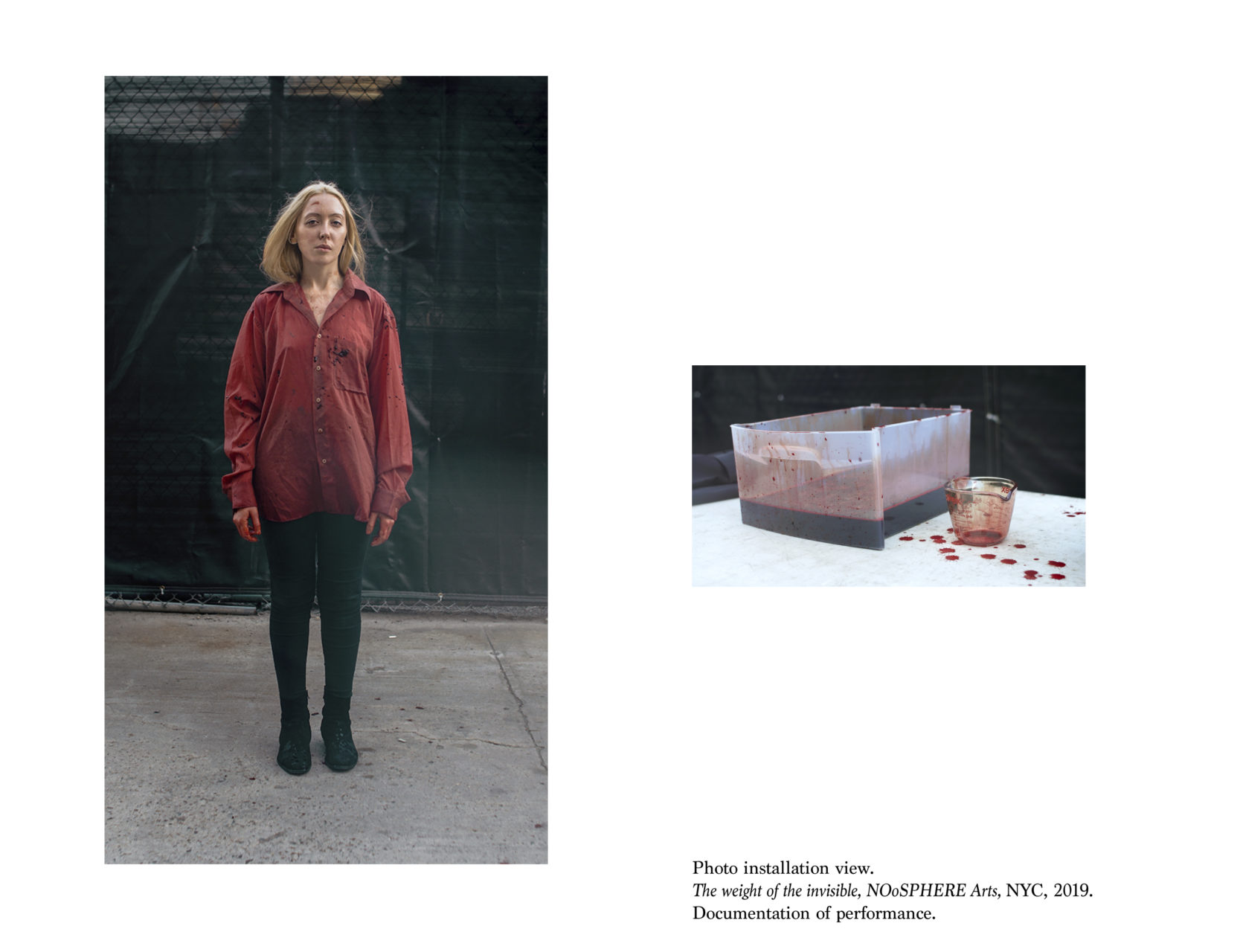PERFORMANCE
NYC, 2019. 35’
PERFORMED AT
NOoSPHERE Arts, NYC. Curated by Sol Kjøk. 2019
Abrons Art Center, final presentation of EMERGENYC program, NYC. 2019
VIDEO I’m Alive (EXCERPT)
VIDEO Can you help me hold this? Inglés (EXCERPT)
EXHIBITED AT
Aborto na Útero, Galeria Útero, Balneario Camboriu, Brasil. 2019
AHORA, Festival de Arte Activista Latinoamericano. Uruguay, Montevideo. 2019
Continuo Latidoamericano de Performance nodo Argentina. 2020
DESCRIPTION
Using a measuring cup, I transferred 400 ml of blood from one plastic container to another, that contained a clean white shirt. The amount of blood was equivalent to the amount of blood a woman loses when taking a Misoprostol pill. To achieve the bleeding caused by clandestine abortions, which take place every half hour in Argentina, I had to repeat the procedure 26 times. At that point, the white shirt, covered in 7 liters of blood, had turned completely red. After taking off my black clothes, I put the shirt on to literally bear the weight of the battle over the passing of the abortion law.
CONCEPT
I’M ALIVE.
I didn’t have an abortion today.
I might need one someday.
51 abortions per hour. 1233 a day. 450.000 abortions a year.
15 liters of blood are shed every hour in illegal abortions in Argentina.
Complications arising from abortions practiced in unsafe conditions have been the leading individual cause of maternal mortality since 1980, and at least 3030 women have died from this cause since the return to democracy in 1983. Official statistics estimate the number of clandestine abortions at 350,000 every year but women’s rights groups think that number may be much higher.
The weight and physical presence of blood are presented in this piece as literal and metaphorical expressions of the issue on abortion. The repetition of the action represents an individual measurement, but in the end translates into the manifestation of collective loss. The shirt is the material vehicle through which the weight is literally experienced on the body: the weight of death, the weight of the fight for the law’s passing, the weight of knowing that this right continues to be denied to women and people capable of conceiving.
El peso de lo invisible
DESCRIPCIÓN
Con una taza medidora, transferí 400 ml de sangre de un recipiente de plástico a otro, que en su interior solo contenía una camisa blanca. La cantidad fue equivalente al nivel de sangre que pierde una mujer al tomar una píldora de Misoprostol. Para alcanzar el sangrado causado por los abortos clandestinos, que se realizan cada media hora en Argentina, tuve que repetir el procedimiento 26 veces. A esa altura, la tela blanca, cubierta de 7 litros de sangre, se había vuelto completamente roja. Después de quitarme la ropa negra, me abotoné la camisa para cargar literalmente con el peso de la batalla sobre la ley del aborto.
CONCEPTUAL
ESTOY VIVA
No me hice un aborto hoy.
Podría necesitar hacerme uno algún día.
51 abortos por hora.
1233 al día.
450.000 abortos al año.
Cada hora se derraman 15 litros de sangre en abortos ilegales en Argentina.
Las complicaciones derivadas de abortos practicados en la clandestinidad han sido la principal causa individual de mortalidad materna desde 1980. Al menos 3030 mujeres han muerto por esta causa desde el retorno a la democracia en 1983. Las estadísticas oficiales estiman el número de abortos clandestinos en 350.000 cada año, pero organizaciones por los derechos de las mujeres creen que el número es mucho mayor.
El peso y la presencia física de la sangre se presentan en esta pieza como expresiones literales y metafóricas de la problemática del aborto. La repetición de la acción que representa una medición individual se traduce finalmente en la manifestación de las pérdidas colectivas. La camisa se constituye como vehículo material mediante el cual el peso se vivencia sobre el cuerpo de forma literal e inexorable: el peso de las muertes, el peso de la lucha por la legalización, el peso de saber que se sigue negando una circunstancia que atenta contra la vida de los cuerpos gestantes.





